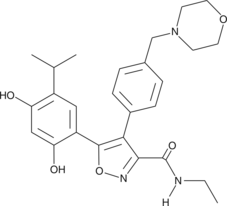Chemicals
Showing 29851–30000 of 41137 results
-
NVP-231 is a potent and reversible inhibitor of ceramide kinase (IC50 = 12 nM).{22065} It is selective for ceramide kinase over SPHK1, SPHK2, DAGKa, PI3Ka, PI4Kb, VPS34, GCS, SMS-1, and CERT (IC50s = >5 mM). NVP-231 inhibits formation of ceramide-1-phosphate (C1P; IC50 = 10 nM) and cell death in ceramide kinase overexpressing COS cells (COS-CerK). It also inhibits C1P formation and tube formation in murine dermal microvascular endothelial cells when used at a concentration of 100 nM.{22067}
Brand:CaymanSKU:-NVP-AAM077 is an NMDA receptor antagonist (IC50 = 0.008 µM).{61130} It is selective for NMDA receptors containing NR1A/NR2A subunits over NMDA receptors containing NR1A/NR2B subunits (IC50s = 0.27 and 29.6 µM, respectively, in X. laevis oocytes expressing receptors containing the respective subunits). NVP-AAM077 inhibits seizures induced by maximal electroshock (MES) in mice with an ED50 value of 23 mg/kg. It increases the activity of neuronal nitric oxide synthase (nNOS) in primary hippocampal neurons.{61131} NVP-AAM077 (10 mg/kg) inhibits proliferation of neural progenitor cells (NPCs) in the subventricular zone (SVZ) and in the subgranular zone (SGZ) of the hippocampal dentate gyrus of adult mice, an effect not seen in nNOS-/- mice. It also increases the escape latency and decreases the percentage of time spent in the target quadrant in the Morris water maze.
Brand:CaymanSKU:30622 - 1 mgAvailable on backorder
NVP-AAM077 is an NMDA receptor antagonist (IC50 = 0.008 µM).{61130} It is selective for NMDA receptors containing NR1A/NR2A subunits over NMDA receptors containing NR1A/NR2B subunits (IC50s = 0.27 and 29.6 µM, respectively, in X. laevis oocytes expressing receptors containing the respective subunits). NVP-AAM077 inhibits seizures induced by maximal electroshock (MES) in mice with an ED50 value of 23 mg/kg. It increases the activity of neuronal nitric oxide synthase (nNOS) in primary hippocampal neurons.{61131} NVP-AAM077 (10 mg/kg) inhibits proliferation of neural progenitor cells (NPCs) in the subventricular zone (SVZ) and in the subgranular zone (SGZ) of the hippocampal dentate gyrus of adult mice, an effect not seen in nNOS-/- mice. It also increases the escape latency and decreases the percentage of time spent in the target quadrant in the Morris water maze.
Brand:CaymanSKU:30622 - 10 mgAvailable on backorder
NVP-AAM077 is an NMDA receptor antagonist (IC50 = 0.008 µM).{61130} It is selective for NMDA receptors containing NR1A/NR2A subunits over NMDA receptors containing NR1A/NR2B subunits (IC50s = 0.27 and 29.6 µM, respectively, in X. laevis oocytes expressing receptors containing the respective subunits). NVP-AAM077 inhibits seizures induced by maximal electroshock (MES) in mice with an ED50 value of 23 mg/kg. It increases the activity of neuronal nitric oxide synthase (nNOS) in primary hippocampal neurons.{61131} NVP-AAM077 (10 mg/kg) inhibits proliferation of neural progenitor cells (NPCs) in the subventricular zone (SVZ) and in the subgranular zone (SGZ) of the hippocampal dentate gyrus of adult mice, an effect not seen in nNOS-/- mice. It also increases the escape latency and decreases the percentage of time spent in the target quadrant in the Morris water maze.
Brand:CaymanSKU:30622 - 25 mgAvailable on backorder
NVP-AAM077 is an NMDA receptor antagonist (IC50 = 0.008 µM).{61130} It is selective for NMDA receptors containing NR1A/NR2A subunits over NMDA receptors containing NR1A/NR2B subunits (IC50s = 0.27 and 29.6 µM, respectively, in X. laevis oocytes expressing receptors containing the respective subunits). NVP-AAM077 inhibits seizures induced by maximal electroshock (MES) in mice with an ED50 value of 23 mg/kg. It increases the activity of neuronal nitric oxide synthase (nNOS) in primary hippocampal neurons.{61131} NVP-AAM077 (10 mg/kg) inhibits proliferation of neural progenitor cells (NPCs) in the subventricular zone (SVZ) and in the subgranular zone (SGZ) of the hippocampal dentate gyrus of adult mice, an effect not seen in nNOS-/- mice. It also increases the escape latency and decreases the percentage of time spent in the target quadrant in the Morris water maze.
Brand:CaymanSKU:30622 - 5 mgAvailable on backorder
NVP-ACC789 is an inhibitor of VEGF receptor tyrosine kinases (VEGFRs; IC50s = 0.38, 0.02, 0.18, and 0.23 μM for human VEGFR1, 2, 3, and mouse Vegfr2, respectively).{37221} It is selective for VEGFRs over FGFRs and PDGFRα (IC50s = >10 μM) but has activity at PDGFRβ (IC50 = 1.4 μM) in an enzyme assay. NVP-ACC789 inhibits VEGF-induced VEGFR2 autophosphorylation (IC50 = 11.5 nM in CHO cells transfected with the human receptor). It also inhibits VEGF- and bFGF-induced angiogenesis and cell migration of BAE and BME cells. In vivo, NVP-ACC789 blocks bFGF- and VEGF-induced angiogenesis (ED50s = 9 and 26 mg/kg, respectively) in a mouse model of growth factor-induced angiogenesis.
Brand:CaymanSKU:23458 - 1 mgAvailable on backorder
NVP-ACC789 is an inhibitor of VEGF receptor tyrosine kinases (VEGFRs; IC50s = 0.38, 0.02, 0.18, and 0.23 μM for human VEGFR1, 2, 3, and mouse Vegfr2, respectively).{37221} It is selective for VEGFRs over FGFRs and PDGFRα (IC50s = >10 μM) but has activity at PDGFRβ (IC50 = 1.4 μM) in an enzyme assay. NVP-ACC789 inhibits VEGF-induced VEGFR2 autophosphorylation (IC50 = 11.5 nM in CHO cells transfected with the human receptor). It also inhibits VEGF- and bFGF-induced angiogenesis and cell migration of BAE and BME cells. In vivo, NVP-ACC789 blocks bFGF- and VEGF-induced angiogenesis (ED50s = 9 and 26 mg/kg, respectively) in a mouse model of growth factor-induced angiogenesis.
Brand:CaymanSKU:23458 - 10 mgAvailable on backorder
NVP-ACC789 is an inhibitor of VEGF receptor tyrosine kinases (VEGFRs; IC50s = 0.38, 0.02, 0.18, and 0.23 μM for human VEGFR1, 2, 3, and mouse Vegfr2, respectively).{37221} It is selective for VEGFRs over FGFRs and PDGFRα (IC50s = >10 μM) but has activity at PDGFRβ (IC50 = 1.4 μM) in an enzyme assay. NVP-ACC789 inhibits VEGF-induced VEGFR2 autophosphorylation (IC50 = 11.5 nM in CHO cells transfected with the human receptor). It also inhibits VEGF- and bFGF-induced angiogenesis and cell migration of BAE and BME cells. In vivo, NVP-ACC789 blocks bFGF- and VEGF-induced angiogenesis (ED50s = 9 and 26 mg/kg, respectively) in a mouse model of growth factor-induced angiogenesis.
Brand:CaymanSKU:23458 - 5 mgAvailable on backorder
NVP-ADW742 is an insulin-like growth factor 1 receptor (IGF-1R) inhibitor with an IC50 value of 0.17 µM.{31811} It exhibits 6-fold greater selectivity for IGF-1R over the insulin receptor (InsR) kinase and minimal inhibitory activity against c-Kit, HER1, PDGFR, VEGFR2, or Bcr-Abl p210.{31811} NVP-ADW742 has been shown to inhibit tumor proliferation both in vitro and in a mouse model of multiple myeloma.{31811}
Brand:CaymanSKU:-Available on backorder
NVP-ADW742 is an insulin-like growth factor 1 receptor (IGF-1R) inhibitor with an IC50 value of 0.17 µM.{31811} It exhibits 6-fold greater selectivity for IGF-1R over the insulin receptor (InsR) kinase and minimal inhibitory activity against c-Kit, HER1, PDGFR, VEGFR2, or Bcr-Abl p210.{31811} NVP-ADW742 has been shown to inhibit tumor proliferation both in vitro and in a mouse model of multiple myeloma.{31811}
Brand:CaymanSKU:-Available on backorder
NVP-ADW742 is an insulin-like growth factor 1 receptor (IGF-1R) inhibitor with an IC50 value of 0.17 µM.{31811} It exhibits 6-fold greater selectivity for IGF-1R over the insulin receptor (InsR) kinase and minimal inhibitory activity against c-Kit, HER1, PDGFR, VEGFR2, or Bcr-Abl p210.{31811} NVP-ADW742 has been shown to inhibit tumor proliferation both in vitro and in a mouse model of multiple myeloma.{31811}
Brand:CaymanSKU:-Available on backorder
NVP-ADW742 is an insulin-like growth factor 1 receptor (IGF-1R) inhibitor with an IC50 value of 0.17 µM.{31811} It exhibits 6-fold greater selectivity for IGF-1R over the insulin receptor (InsR) kinase and minimal inhibitory activity against c-Kit, HER1, PDGFR, VEGFR2, or Bcr-Abl p210.{31811} NVP-ADW742 has been shown to inhibit tumor proliferation both in vitro and in a mouse model of multiple myeloma.{31811}
Brand:CaymanSKU:-Available on backorder
Hsp90 is a molecular chaperone of many different kinases, transcription factors, and hormone receptors involved in signal transduction, cell cycle regulation, and apoptosis. In addition to its important function in normal cell homeostasis, a high affinity form of Hsp90 is prevalent in tumor cells. Hsp90 inhibition has been associated with the degradation of oncogenic client proteins. NVP-AUY922 is a Hsp90 inhibitor (IC50 = 21 nM in a FP binding assay) that prevents the proliferation of a range of human cancer cell lines in vitro with GI50s averaging 9 nM.{15809} In a human colon cancer xenograft model, 50 mg/kg NVP-AUY922 inhibits tumor growth by ~50% compared to vehicle controls.{15809} Unlike some first generation Hsp90 inhibitors that are quickly glucuronidated, NVP-AUY922 is retained in tumors in vivo when administered at 4 mg/kg i.p. by cassette dosing in tumor-bearing mice.{15809}
Brand:CaymanSKU:10012698 - 10 mgAvailable on backorder
Hsp90 is a molecular chaperone of many different kinases, transcription factors, and hormone receptors involved in signal transduction, cell cycle regulation, and apoptosis. In addition to its important function in normal cell homeostasis, a high affinity form of Hsp90 is prevalent in tumor cells. Hsp90 inhibition has been associated with the degradation of oncogenic client proteins. NVP-AUY922 is a Hsp90 inhibitor (IC50 = 21 nM in a FP binding assay) that prevents the proliferation of a range of human cancer cell lines in vitro with GI50s averaging 9 nM.{15809} In a human colon cancer xenograft model, 50 mg/kg NVP-AUY922 inhibits tumor growth by ~50% compared to vehicle controls.{15809} Unlike some first generation Hsp90 inhibitors that are quickly glucuronidated, NVP-AUY922 is retained in tumors in vivo when administered at 4 mg/kg i.p. by cassette dosing in tumor-bearing mice.{15809}
Brand:CaymanSKU:10012698 - 5 mgAvailable on backorder
NVP-BAG956 is a dual inhibitor of 3-phosphoinositide-dependent protein kinase 1 (PDK1; IC50 = 245 nM) and class I phosphatidylinositol 3-kinase catalytic subunits (PI3Ks; IC50s = 56, 446, 35, and 117 nM for p110α, p110β, p110δ, and p110γ, respectively).{36931} It inhibits phosphorylation of T308-PKB (IC50 = 45 nM) in and proliferation of U87MG cells (EC50 = 143 nM). NVP-BAG956 decreases cell viability in a panel of human leukemia cell lines (IC50s = 1 phase in MOLM-14 cells and reduces colony formation by patient-derived acute myeloid leukemia (AML) cells. NVP-BAG956 (75 mg/kg) reduces tumor burden in mice injected with 32D.p210-luc+cells when administered in combination with everolimus (Item No. 11597).
Brand:CaymanSKU:24195 - 1 mgAvailable on backorder
NVP-BAG956 is a dual inhibitor of 3-phosphoinositide-dependent protein kinase 1 (PDK1; IC50 = 245 nM) and class I phosphatidylinositol 3-kinase catalytic subunits (PI3Ks; IC50s = 56, 446, 35, and 117 nM for p110α, p110β, p110δ, and p110γ, respectively).{36931} It inhibits phosphorylation of T308-PKB (IC50 = 45 nM) in and proliferation of U87MG cells (EC50 = 143 nM). NVP-BAG956 decreases cell viability in a panel of human leukemia cell lines (IC50s = 1 phase in MOLM-14 cells and reduces colony formation by patient-derived acute myeloid leukemia (AML) cells. NVP-BAG956 (75 mg/kg) reduces tumor burden in mice injected with 32D.p210-luc+cells when administered in combination with everolimus (Item No. 11597).
Brand:CaymanSKU:24195 - 10 mgAvailable on backorder
NVP-BAG956 is a dual inhibitor of 3-phosphoinositide-dependent protein kinase 1 (PDK1; IC50 = 245 nM) and class I phosphatidylinositol 3-kinase catalytic subunits (PI3Ks; IC50s = 56, 446, 35, and 117 nM for p110α, p110β, p110δ, and p110γ, respectively).{36931} It inhibits phosphorylation of T308-PKB (IC50 = 45 nM) in and proliferation of U87MG cells (EC50 = 143 nM). NVP-BAG956 decreases cell viability in a panel of human leukemia cell lines (IC50s = 1 phase in MOLM-14 cells and reduces colony formation by patient-derived acute myeloid leukemia (AML) cells. NVP-BAG956 (75 mg/kg) reduces tumor burden in mice injected with 32D.p210-luc+cells when administered in combination with everolimus (Item No. 11597).
Brand:CaymanSKU:24195 - 5 mgAvailable on backorder
NVP-BEP800 is an inhibitor of heat shock protein 90 (Hsp90; IC50 = 58 nM for recombinant human Hsp90β).{29919} It is selective for Hsp90 over the chaperones GRP94 and TRAP1 (IC50s = 4.1 and 5.5 µM, respectively). NVP-BEP800 inhibits the growth of BT474, SK-BR-3, MCF-7, MDA-MB-157, MDA-MB-231, MDA-MB-468, and BT-20 breast cancer cells (GI50s = 53, 56, 118, 89, 190, 173, and 162 nM, respectively). It reduces levels of the Hsp90 target proteins HER2 and Raf-1 in MCF-7 cells. NVP-BEP800 induces apoptosis and attenuates X-ray-induced increases in Hsp70 levels in T98G glioblastoma cells.{29922} NVP-BEP800 (15-50 mg/kg) reduces tumor volume in A375 melanoma and BT474 breast cancer mouse xenograft models.{29919} It also reduces tumor volume in an L1T2 Kaposi sarcoma mouse xenograft model.{29918}
Brand:CaymanSKU:-Available on backorder
NVP-BEP800 is an inhibitor of heat shock protein 90 (Hsp90; IC50 = 58 nM for recombinant human Hsp90β).{29919} It is selective for Hsp90 over the chaperones GRP94 and TRAP1 (IC50s = 4.1 and 5.5 µM, respectively). NVP-BEP800 inhibits the growth of BT474, SK-BR-3, MCF-7, MDA-MB-157, MDA-MB-231, MDA-MB-468, and BT-20 breast cancer cells (GI50s = 53, 56, 118, 89, 190, 173, and 162 nM, respectively). It reduces levels of the Hsp90 target proteins HER2 and Raf-1 in MCF-7 cells. NVP-BEP800 induces apoptosis and attenuates X-ray-induced increases in Hsp70 levels in T98G glioblastoma cells.{29922} NVP-BEP800 (15-50 mg/kg) reduces tumor volume in A375 melanoma and BT474 breast cancer mouse xenograft models.{29919} It also reduces tumor volume in an L1T2 Kaposi sarcoma mouse xenograft model.{29918}
Brand:CaymanSKU:-Available on backorder
NVP-BEP800 is an inhibitor of heat shock protein 90 (Hsp90; IC50 = 58 nM for recombinant human Hsp90β).{29919} It is selective for Hsp90 over the chaperones GRP94 and TRAP1 (IC50s = 4.1 and 5.5 µM, respectively). NVP-BEP800 inhibits the growth of BT474, SK-BR-3, MCF-7, MDA-MB-157, MDA-MB-231, MDA-MB-468, and BT-20 breast cancer cells (GI50s = 53, 56, 118, 89, 190, 173, and 162 nM, respectively). It reduces levels of the Hsp90 target proteins HER2 and Raf-1 in MCF-7 cells. NVP-BEP800 induces apoptosis and attenuates X-ray-induced increases in Hsp70 levels in T98G glioblastoma cells.{29922} NVP-BEP800 (15-50 mg/kg) reduces tumor volume in A375 melanoma and BT474 breast cancer mouse xenograft models.{29919} It also reduces tumor volume in an L1T2 Kaposi sarcoma mouse xenograft model.{29918}
Brand:CaymanSKU:-Available on backorder
NVP-BEP800 is an inhibitor of heat shock protein 90 (Hsp90; IC50 = 58 nM for recombinant human Hsp90β).{29919} It is selective for Hsp90 over the chaperones GRP94 and TRAP1 (IC50s = 4.1 and 5.5 µM, respectively). NVP-BEP800 inhibits the growth of BT474, SK-BR-3, MCF-7, MDA-MB-157, MDA-MB-231, MDA-MB-468, and BT-20 breast cancer cells (GI50s = 53, 56, 118, 89, 190, 173, and 162 nM, respectively). It reduces levels of the Hsp90 target proteins HER2 and Raf-1 in MCF-7 cells. NVP-BEP800 induces apoptosis and attenuates X-ray-induced increases in Hsp70 levels in T98G glioblastoma cells.{29922} NVP-BEP800 (15-50 mg/kg) reduces tumor volume in A375 melanoma and BT474 breast cancer mouse xenograft models.{29919} It also reduces tumor volume in an L1T2 Kaposi sarcoma mouse xenograft model.{29918}
Brand:CaymanSKU:-Available on backorder
Phosphatidylinositol 3-kinase (PI3K) signaling through Akt/PKB and the mammalian target of rapamycin (mTOR) controls gene expression related to cell proliferation, differentiation, and apoptosis. Increased activity of this pathway is important in many types of cancer. NVP-BEZ235 is a potent dual inhibitor of PI3K and mTOR that is well tolerated, displays disease stasis when administered orally, and enhances the efficacy of other anticancer agents when used in in vivo combination studies.{18570,18573} It inhibits PI3K isoforms and mutants with low nanomolar IC50 values, leading to growth arrest in the G1 phase.{18570,18572} Through its effects on PI3K, NVP-BEZ235 inhibits VEGF-induced angiogenesis.{18571} By directly blocking cell growth and indirectly inhibiting angiogenesis, it has potential in both solid tumors and in metastatic melanoma therapy.{18574,18575}
Brand:CaymanSKU:10565 - 100 mgAvailable on backorder
Phosphatidylinositol 3-kinase (PI3K) signaling through Akt/PKB and the mammalian target of rapamycin (mTOR) controls gene expression related to cell proliferation, differentiation, and apoptosis. Increased activity of this pathway is important in many types of cancer. NVP-BEZ235 is a potent dual inhibitor of PI3K and mTOR that is well tolerated, displays disease stasis when administered orally, and enhances the efficacy of other anticancer agents when used in in vivo combination studies.{18570,18573} It inhibits PI3K isoforms and mutants with low nanomolar IC50 values, leading to growth arrest in the G1 phase.{18570,18572} Through its effects on PI3K, NVP-BEZ235 inhibits VEGF-induced angiogenesis.{18571} By directly blocking cell growth and indirectly inhibiting angiogenesis, it has potential in both solid tumors and in metastatic melanoma therapy.{18574,18575}
Brand:CaymanSKU:10565 - 25 mgAvailable on backorder
Phosphatidylinositol 3-kinase (PI3K) signaling through Akt/PKB and the mammalian target of rapamycin (mTOR) controls gene expression related to cell proliferation, differentiation, and apoptosis. Increased activity of this pathway is important in many types of cancer. NVP-BEZ235 is a potent dual inhibitor of PI3K and mTOR that is well tolerated, displays disease stasis when administered orally, and enhances the efficacy of other anticancer agents when used in in vivo combination studies.{18570,18573} It inhibits PI3K isoforms and mutants with low nanomolar IC50 values, leading to growth arrest in the G1 phase.{18570,18572} Through its effects on PI3K, NVP-BEZ235 inhibits VEGF-induced angiogenesis.{18571} By directly blocking cell growth and indirectly inhibiting angiogenesis, it has potential in both solid tumors and in metastatic melanoma therapy.{18574,18575}
Brand:CaymanSKU:10565 - 250 mgAvailable on backorder
Phosphatidylinositol 3-kinase (PI3K) signaling through Akt/PKB and the mammalian target of rapamycin (mTOR) controls gene expression related to cell proliferation, differentiation, and apoptosis. Increased activity of this pathway is important in many types of cancer. NVP-BEZ235 is a potent dual inhibitor of PI3K and mTOR that is well tolerated, displays disease stasis when administered orally, and enhances the efficacy of other anticancer agents when used in in vivo combination studies.{18570,18573} It inhibits PI3K isoforms and mutants with low nanomolar IC50 values, leading to growth arrest in the G1 phase.{18570,18572} Through its effects on PI3K, NVP-BEZ235 inhibits VEGF-induced angiogenesis.{18571} By directly blocking cell growth and indirectly inhibiting angiogenesis, it has potential in both solid tumors and in metastatic melanoma therapy.{18574,18575}
Brand:CaymanSKU:10565 - 50 mgAvailable on backorder
NVP-BGT226 is an orally bioavailable dual inhibitor of phosphatidylinositol 3-kinase (PI3K) and the mammalian target of rapamycin (mTOR).{35140} It inhibits class I PI3Ks with EC50 values of 4, 63, and 38 nM for PI3Kα, β, and γ isoforms, respectively, in a filter binding assay. It binds to both class I and class III PI3Ks in a quantitative ELISA assay with EC50 values of 55.8 and 7.03 nM, for HsPI3Kβ and HsVps34, respectively.{35142} It decreases protein levels of phosphorylated mTOR and Akt, a downstream target of PI3K signaling.{36351} NVP-BGT226 inhibits the growth of squamous cell carcinoma cell lines, HONE-1, and a variant of HONE-1 resistant to cisplatin (Item No. 13119) with IC50 values of 7.4-27.8, 22.6, and 30.1 nM, respectively.{35138} It halts the cell cycle at the G0/G1 phase and induces autophagy. NVP-BGT226 (2.5 and 5 mg/kg daily for three weeks) inhibits tumor growth in a FaDu head and neck cancer mouse xenograft model.
Brand:CaymanSKU:22142 -Out of stock
NVP-BGT226 is an orally bioavailable dual inhibitor of phosphatidylinositol 3-kinase (PI3K) and the mammalian target of rapamycin (mTOR).{35140} It inhibits class I PI3Ks with EC50 values of 4, 63, and 38 nM for PI3Kα, β, and γ isoforms, respectively, in a filter binding assay. It binds to both class I and class III PI3Ks in a quantitative ELISA assay with EC50 values of 55.8 and 7.03 nM, for HsPI3Kβ and HsVps34, respectively.{35142} It decreases protein levels of phosphorylated mTOR and Akt, a downstream target of PI3K signaling.{36351} NVP-BGT226 inhibits the growth of squamous cell carcinoma cell lines, HONE-1, and a variant of HONE-1 resistant to cisplatin (Item No. 13119) with IC50 values of 7.4-27.8, 22.6, and 30.1 nM, respectively.{35138} It halts the cell cycle at the G0/G1 phase and induces autophagy. NVP-BGT226 (2.5 and 5 mg/kg daily for three weeks) inhibits tumor growth in a FaDu head and neck cancer mouse xenograft model.
Brand:CaymanSKU:22142 -Out of stock
NVP-BGT226 is an orally bioavailable dual inhibitor of phosphatidylinositol 3-kinase (PI3K) and the mammalian target of rapamycin (mTOR).{35140} It inhibits class I PI3Ks with EC50 values of 4, 63, and 38 nM for PI3Kα, β, and γ isoforms, respectively, in a filter binding assay. It binds to both class I and class III PI3Ks in a quantitative ELISA assay with EC50 values of 55.8 and 7.03 nM, for HsPI3Kβ and HsVps34, respectively.{35142} It decreases protein levels of phosphorylated mTOR and Akt, a downstream target of PI3K signaling.{36351} NVP-BGT226 inhibits the growth of squamous cell carcinoma cell lines, HONE-1, and a variant of HONE-1 resistant to cisplatin (Item No. 13119) with IC50 values of 7.4-27.8, 22.6, and 30.1 nM, respectively.{35138} It halts the cell cycle at the G0/G1 phase and induces autophagy. NVP-BGT226 (2.5 and 5 mg/kg daily for three weeks) inhibits tumor growth in a FaDu head and neck cancer mouse xenograft model.
Brand:CaymanSKU:22142 -Out of stock
NVP-BGT226 is an orally bioavailable dual inhibitor of phosphatidylinositol 3-kinase (PI3K) and the mammalian target of rapamycin (mTOR).{35140} It inhibits class I PI3Ks with EC50 values of 4, 63, and 38 nM for PI3Kα, β, and γ isoforms, respectively, in a filter binding assay. It binds to both class I and class III PI3Ks in a quantitative ELISA assay with EC50 values of 55.8 and 7.03 nM, for HsPI3Kβ and HsVps34, respectively.{35142} It decreases protein levels of phosphorylated mTOR and Akt, a downstream target of PI3K signaling.{36351} NVP-BGT226 inhibits the growth of squamous cell carcinoma cell lines, HONE-1, and a variant of HONE-1 resistant to cisplatin (Item No. 13119) with IC50 values of 7.4-27.8, 22.6, and 30.1 nM, respectively.{35138} It halts the cell cycle at the G0/G1 phase and induces autophagy. NVP-BGT226 (2.5 and 5 mg/kg daily for three weeks) inhibits tumor growth in a FaDu head and neck cancer mouse xenograft model.
Brand:CaymanSKU:22142 -Out of stock
The EphB4 receptor tyrosine kinase (cloned from erythropoietin-producing hepatocellular carcinoma) and its ligand ephrinB2 play an important role in embryonic vessel development and vascular remodeling. Signaling from this pair is also involved in tumor angiogenesis. NVP-BHG712 is an orally bioavailable inhibitor of EphB4 kinase autophosphorylation (ED50 = 25 nM).{29822} It is selective for EphB4, demonstrating an ED50 value of 4.2 µM at the related VEGFR2 receptor and ED50 values >10 µM against a panel of 40 additional kinases.{29822} At 3-30 mg/kg, NVP-BHG712 dose dependently inhibits VEGF-directed vessel formation in an in vivo mouse model of angiogenesis.{29822}
Brand:CaymanSKU:-Available on backorder
The EphB4 receptor tyrosine kinase (cloned from erythropoietin-producing hepatocellular carcinoma) and its ligand ephrinB2 play an important role in embryonic vessel development and vascular remodeling. Signaling from this pair is also involved in tumor angiogenesis. NVP-BHG712 is an orally bioavailable inhibitor of EphB4 kinase autophosphorylation (ED50 = 25 nM).{29822} It is selective for EphB4, demonstrating an ED50 value of 4.2 µM at the related VEGFR2 receptor and ED50 values >10 µM against a panel of 40 additional kinases.{29822} At 3-30 mg/kg, NVP-BHG712 dose dependently inhibits VEGF-directed vessel formation in an in vivo mouse model of angiogenesis.{29822}
Brand:CaymanSKU:-Available on backorder
The EphB4 receptor tyrosine kinase (cloned from erythropoietin-producing hepatocellular carcinoma) and its ligand ephrinB2 play an important role in embryonic vessel development and vascular remodeling. Signaling from this pair is also involved in tumor angiogenesis. NVP-BHG712 is an orally bioavailable inhibitor of EphB4 kinase autophosphorylation (ED50 = 25 nM).{29822} It is selective for EphB4, demonstrating an ED50 value of 4.2 µM at the related VEGFR2 receptor and ED50 values >10 µM against a panel of 40 additional kinases.{29822} At 3-30 mg/kg, NVP-BHG712 dose dependently inhibits VEGF-directed vessel formation in an in vivo mouse model of angiogenesis.{29822}
Brand:CaymanSKU:-Available on backorder
The EphB4 receptor tyrosine kinase (cloned from erythropoietin-producing hepatocellular carcinoma) and its ligand ephrinB2 play an important role in embryonic vessel development and vascular remodeling. Signaling from this pair is also involved in tumor angiogenesis. NVP-BHG712 is an orally bioavailable inhibitor of EphB4 kinase autophosphorylation (ED50 = 25 nM).{29822} It is selective for EphB4, demonstrating an ED50 value of 4.2 µM at the related VEGFR2 receptor and ED50 values >10 µM against a panel of 40 additional kinases.{29822} At 3-30 mg/kg, NVP-BHG712 dose dependently inhibits VEGF-directed vessel formation in an in vivo mouse model of angiogenesis.{29822}
Brand:CaymanSKU:-Available on backorder
NVP-BKM120 is an orally bioavailable inhibitor of the class I PI3K isoforms p110α (IC50 = 52 nM) and p110β (IC50 = 166 nM).{23146} It is selective for these isoforms over the class III PI3K Vps34 (IC50 = 2,410 nM), the mammalian target of rapamycin (mTOR; IC50 = 2,866 nM), PI4Kβ (IC50 = >25,000 nM), and a variety of kinases (IC50s = >10,000 nM). NVP-BKM120 inhibits proliferation of human tumor and glioma cell lines, with p53 wild-type glioma cells being more sensitive than p53 mutant/deleted glioma cells (IC50s = 1.28 and 2.08 µM, respectively).{23147,23145} It halts the cell cycle in the G2/M phase in both p53 wild-type and p53 mutant/deleted glioma cells, but p53 mutant/deleted cells reenter the cell cycle, progress into mitosis, and die via mitotic catastrophic cell death. NVP-BKM120 (1-5 mg/kg) crosses the blood brain barrier and selectively decreases phosphorylation of the PI3K target protein Akt.{36845} It increases survival in a U87 glioma mouse xenograft intracranial tumor model when administered orally at doses of 20 and 40 mg/kg once per week.{23147}
Brand:CaymanSKU:11587 - 1 mgAvailable on backorder
NVP-BKM120 is an orally bioavailable inhibitor of the class I PI3K isoforms p110α (IC50 = 52 nM) and p110β (IC50 = 166 nM).{23146} It is selective for these isoforms over the class III PI3K Vps34 (IC50 = 2,410 nM), the mammalian target of rapamycin (mTOR; IC50 = 2,866 nM), PI4Kβ (IC50 = >25,000 nM), and a variety of kinases (IC50s = >10,000 nM). NVP-BKM120 inhibits proliferation of human tumor and glioma cell lines, with p53 wild-type glioma cells being more sensitive than p53 mutant/deleted glioma cells (IC50s = 1.28 and 2.08 µM, respectively).{23147,23145} It halts the cell cycle in the G2/M phase in both p53 wild-type and p53 mutant/deleted glioma cells, but p53 mutant/deleted cells reenter the cell cycle, progress into mitosis, and die via mitotic catastrophic cell death. NVP-BKM120 (1-5 mg/kg) crosses the blood brain barrier and selectively decreases phosphorylation of the PI3K target protein Akt.{36845} It increases survival in a U87 glioma mouse xenograft intracranial tumor model when administered orally at doses of 20 and 40 mg/kg once per week.{23147}
Brand:CaymanSKU:11587 - 10 mgAvailable on backorder
NVP-BKM120 is an orally bioavailable inhibitor of the class I PI3K isoforms p110α (IC50 = 52 nM) and p110β (IC50 = 166 nM).{23146} It is selective for these isoforms over the class III PI3K Vps34 (IC50 = 2,410 nM), the mammalian target of rapamycin (mTOR; IC50 = 2,866 nM), PI4Kβ (IC50 = >25,000 nM), and a variety of kinases (IC50s = >10,000 nM). NVP-BKM120 inhibits proliferation of human tumor and glioma cell lines, with p53 wild-type glioma cells being more sensitive than p53 mutant/deleted glioma cells (IC50s = 1.28 and 2.08 µM, respectively).{23147,23145} It halts the cell cycle in the G2/M phase in both p53 wild-type and p53 mutant/deleted glioma cells, but p53 mutant/deleted cells reenter the cell cycle, progress into mitosis, and die via mitotic catastrophic cell death. NVP-BKM120 (1-5 mg/kg) crosses the blood brain barrier and selectively decreases phosphorylation of the PI3K target protein Akt.{36845} It increases survival in a U87 glioma mouse xenograft intracranial tumor model when administered orally at doses of 20 and 40 mg/kg once per week.{23147}
Brand:CaymanSKU:11587 - 25 mgAvailable on backorder
NVP-BKM120 is an orally bioavailable inhibitor of the class I PI3K isoforms p110α (IC50 = 52 nM) and p110β (IC50 = 166 nM).{23146} It is selective for these isoforms over the class III PI3K Vps34 (IC50 = 2,410 nM), the mammalian target of rapamycin (mTOR; IC50 = 2,866 nM), PI4Kβ (IC50 = >25,000 nM), and a variety of kinases (IC50s = >10,000 nM). NVP-BKM120 inhibits proliferation of human tumor and glioma cell lines, with p53 wild-type glioma cells being more sensitive than p53 mutant/deleted glioma cells (IC50s = 1.28 and 2.08 µM, respectively).{23147,23145} It halts the cell cycle in the G2/M phase in both p53 wild-type and p53 mutant/deleted glioma cells, but p53 mutant/deleted cells reenter the cell cycle, progress into mitosis, and die via mitotic catastrophic cell death. NVP-BKM120 (1-5 mg/kg) crosses the blood brain barrier and selectively decreases phosphorylation of the PI3K target protein Akt.{36845} It increases survival in a U87 glioma mouse xenograft intracranial tumor model when administered orally at doses of 20 and 40 mg/kg once per week.{23147}
Brand:CaymanSKU:11587 - 5 mgAvailable on backorder
Janus kinases (JAKs) are non-receptor tyrosine kinases that mediate signaling through cytokine receptors, often to members of the signal transducer and activator of transcription (STAT) family.{20362} A point mutation of JAK2, V617F, activates signaling through STAT5 and drives certain forms of cancer.{27443} NVP-BSK805 is a potent inhibitor of JAK2 that also inhibits the JAK2V617F mutant enzyme (IC50s for both enzymes ~ 0.5 nM). It displays at least 20-fold selectivity against other JAK enzymes and a panel of serine/threonine and tyrosine kinases.{27443} This ATP-competitive inhibitor is orally bioavailable and has a long half-life in vivo, suppressing leukemic cell spreading and splenomegaly in JAK2V617F cell-driven disease in mice.{27443} NVP-BSK805 suppresses recombinant human erythropoietin-induced polycythemia and extramedullary erythropoiesis in mice and rats.{27443} NVP-BSK805 can be used to study the molecular mechanisms involved in JAK2V617F signaling in cells.{27444}
Brand:CaymanSKU:-Out of stock
Janus kinases (JAKs) are non-receptor tyrosine kinases that mediate signaling through cytokine receptors, often to members of the signal transducer and activator of transcription (STAT) family.{20362} A point mutation of JAK2, V617F, activates signaling through STAT5 and drives certain forms of cancer.{27443} NVP-BSK805 is a potent inhibitor of JAK2 that also inhibits the JAK2V617F mutant enzyme (IC50s for both enzymes ~ 0.5 nM). It displays at least 20-fold selectivity against other JAK enzymes and a panel of serine/threonine and tyrosine kinases.{27443} This ATP-competitive inhibitor is orally bioavailable and has a long half-life in vivo, suppressing leukemic cell spreading and splenomegaly in JAK2V617F cell-driven disease in mice.{27443} NVP-BSK805 suppresses recombinant human erythropoietin-induced polycythemia and extramedullary erythropoiesis in mice and rats.{27443} NVP-BSK805 can be used to study the molecular mechanisms involved in JAK2V617F signaling in cells.{27444}
Brand:CaymanSKU:-Out of stock
Janus kinases (JAKs) are non-receptor tyrosine kinases that mediate signaling through cytokine receptors, often to members of the signal transducer and activator of transcription (STAT) family.{20362} A point mutation of JAK2, V617F, activates signaling through STAT5 and drives certain forms of cancer.{27443} NVP-BSK805 is a potent inhibitor of JAK2 that also inhibits the JAK2V617F mutant enzyme (IC50s for both enzymes ~ 0.5 nM). It displays at least 20-fold selectivity against other JAK enzymes and a panel of serine/threonine and tyrosine kinases.{27443} This ATP-competitive inhibitor is orally bioavailable and has a long half-life in vivo, suppressing leukemic cell spreading and splenomegaly in JAK2V617F cell-driven disease in mice.{27443} NVP-BSK805 suppresses recombinant human erythropoietin-induced polycythemia and extramedullary erythropoiesis in mice and rats.{27443} NVP-BSK805 can be used to study the molecular mechanisms involved in JAK2V617F signaling in cells.{27444}
Brand:CaymanSKU:-Out of stock
NVP-CGM097 is an inhibitor of the protein-protein interaction between murine double minute 2 (MDM2) and p53 (IC50 = 1.7 nM for human MDM2 in a TR-FRET assay).{53380} It is selective for human MDM2 (Ki = 1.3 nM) over dog, mouse, and rat Mdm2 (Kis = 20.5, 65.9, and 47.4 nM, respectively).{53381} NVP-CGM097 selectively inhibits proliferation of acute myeloid leukemia (AML) cells expressing wild-type p53 (IC50s = 50-1,000 nM) over AML cells expressing mutant p53 (IC50s = >1,000 nM).{53380} It induces tumor regression in a patient-derived xenograft (PDX) mouse model of AML when administered at a dose of 100 mg/kg per day.{53380}
Brand:CaymanSKU:29519 - 1 mgAvailable on backorder
NVP-CGM097 is an inhibitor of the protein-protein interaction between murine double minute 2 (MDM2) and p53 (IC50 = 1.7 nM for human MDM2 in a TR-FRET assay).{53380} It is selective for human MDM2 (Ki = 1.3 nM) over dog, mouse, and rat Mdm2 (Kis = 20.5, 65.9, and 47.4 nM, respectively).{53381} NVP-CGM097 selectively inhibits proliferation of acute myeloid leukemia (AML) cells expressing wild-type p53 (IC50s = 50-1,000 nM) over AML cells expressing mutant p53 (IC50s = >1,000 nM).{53380} It induces tumor regression in a patient-derived xenograft (PDX) mouse model of AML when administered at a dose of 100 mg/kg per day.{53380}
Brand:CaymanSKU:29519 - 10 mgAvailable on backorder
NVP-CGM097 is an inhibitor of the protein-protein interaction between murine double minute 2 (MDM2) and p53 (IC50 = 1.7 nM for human MDM2 in a TR-FRET assay).{53380} It is selective for human MDM2 (Ki = 1.3 nM) over dog, mouse, and rat Mdm2 (Kis = 20.5, 65.9, and 47.4 nM, respectively).{53381} NVP-CGM097 selectively inhibits proliferation of acute myeloid leukemia (AML) cells expressing wild-type p53 (IC50s = 50-1,000 nM) over AML cells expressing mutant p53 (IC50s = >1,000 nM).{53380} It induces tumor regression in a patient-derived xenograft (PDX) mouse model of AML when administered at a dose of 100 mg/kg per day.{53380}
Brand:CaymanSKU:29519 - 5 mgAvailable on backorder
NVP-TAE226 is an inhibitor of focal adhesion kinase (FAK; IC50 = 5.5 nM) and the related proline-rich tyrosine kinase 2-β (PYK2β; IC50 = 5 nM).{32642} It can also inhibit the insulin-like growth factor 1 receptor (IC50 = 0.16 µM) as well as the activity of its downstream target genes such as MAPK and Akt.{32642} NVP-TAE226 has been shown to inhibit glioma and ovarian tumor growth in in vivo tumor models.{15631}
Brand:CaymanSKU:-Available on backorder
NVP-TAE226 is an inhibitor of focal adhesion kinase (FAK; IC50 = 5.5 nM) and the related proline-rich tyrosine kinase 2-β (PYK2β; IC50 = 5 nM).{32642} It can also inhibit the insulin-like growth factor 1 receptor (IC50 = 0.16 µM) as well as the activity of its downstream target genes such as MAPK and Akt.{32642} NVP-TAE226 has been shown to inhibit glioma and ovarian tumor growth in in vivo tumor models.{15631}
Brand:CaymanSKU:-Available on backorder
NVP-TAE226 is an inhibitor of focal adhesion kinase (FAK; IC50 = 5.5 nM) and the related proline-rich tyrosine kinase 2-β (PYK2β; IC50 = 5 nM).{32642} It can also inhibit the insulin-like growth factor 1 receptor (IC50 = 0.16 µM) as well as the activity of its downstream target genes such as MAPK and Akt.{32642} NVP-TAE226 has been shown to inhibit glioma and ovarian tumor growth in in vivo tumor models.{15631}
Brand:CaymanSKU:-Available on backorder
NVP-TAE226 is an inhibitor of focal adhesion kinase (FAK; IC50 = 5.5 nM) and the related proline-rich tyrosine kinase 2-β (PYK2β; IC50 = 5 nM).{32642} It can also inhibit the insulin-like growth factor 1 receptor (IC50 = 0.16 µM) as well as the activity of its downstream target genes such as MAPK and Akt.{32642} NVP-TAE226 has been shown to inhibit glioma and ovarian tumor growth in in vivo tumor models.{15631}
Brand:CaymanSKU:-Available on backorder
NVP-TNKS656 is an orally bioavailable inhibitor of tankyrase 2 (TNKS2; IC50 = 6 nM).{40669} It is selective for TNKS2 over poly(ADP-ribose) polymerase (PARP) 1 and 2 (IC50s = >19 and 32 nM, respectively). NVP-TNKS656 inhibits Wnt ligand-induced signaling with an IC50 value of 3.5 nM in an HEK293 cell reporter assay. In vivo, NVP-TNKS656 (350 mg/kg) reduces Axin 2 mRNA expression, a Wnt/β-catenin target gene, in MMTV-Wnt1 tumor bearing mice.
Brand:CaymanSKU:19930 -Available on backorder
NVP-TNKS656 is an orally bioavailable inhibitor of tankyrase 2 (TNKS2; IC50 = 6 nM).{40669} It is selective for TNKS2 over poly(ADP-ribose) polymerase (PARP) 1 and 2 (IC50s = >19 and 32 nM, respectively). NVP-TNKS656 inhibits Wnt ligand-induced signaling with an IC50 value of 3.5 nM in an HEK293 cell reporter assay. In vivo, NVP-TNKS656 (350 mg/kg) reduces Axin 2 mRNA expression, a Wnt/β-catenin target gene, in MMTV-Wnt1 tumor bearing mice.
Brand:CaymanSKU:19930 -Available on backorder
NVP-TNKS656 is an orally bioavailable inhibitor of tankyrase 2 (TNKS2; IC50 = 6 nM).{40669} It is selective for TNKS2 over poly(ADP-ribose) polymerase (PARP) 1 and 2 (IC50s = >19 and 32 nM, respectively). NVP-TNKS656 inhibits Wnt ligand-induced signaling with an IC50 value of 3.5 nM in an HEK293 cell reporter assay. In vivo, NVP-TNKS656 (350 mg/kg) reduces Axin 2 mRNA expression, a Wnt/β-catenin target gene, in MMTV-Wnt1 tumor bearing mice.
Brand:CaymanSKU:19930 -Available on backorder
NVP-TNKS656 is an orally bioavailable inhibitor of tankyrase 2 (TNKS2; IC50 = 6 nM).{40669} It is selective for TNKS2 over poly(ADP-ribose) polymerase (PARP) 1 and 2 (IC50s = >19 and 32 nM, respectively). NVP-TNKS656 inhibits Wnt ligand-induced signaling with an IC50 value of 3.5 nM in an HEK293 cell reporter assay. In vivo, NVP-TNKS656 (350 mg/kg) reduces Axin 2 mRNA expression, a Wnt/β-catenin target gene, in MMTV-Wnt1 tumor bearing mice.
Brand:CaymanSKU:19930 -Available on backorder
NVS-CECR2-1 is a potent inhibitor of CECR2 (cat eye syndrome chromosome region, candidate 2), a component of chromatin complexes that regulate gene expression controlling development. It binds CECR2 with high affinity (IC50 = 0.047 µM by Alpha screen, Kd = 0.80 µM by ITC). NVS-CECR2-1 demonstrates no crossreactivity in a panel of 48 bromodomains and has no major activity in kinase, protease, and receptor panels. It shows robust activity in cells by FRAP assay, due to its slow off-rate, and has no acute toxicity. See the Structural Genomics Consortium (SGC) website for more information.
Brand:CaymanSKU:-Available on backorder
NVS-CECR2-1 is a potent inhibitor of CECR2 (cat eye syndrome chromosome region, candidate 2), a component of chromatin complexes that regulate gene expression controlling development. It binds CECR2 with high affinity (IC50 = 0.047 µM by Alpha screen, Kd = 0.80 µM by ITC). NVS-CECR2-1 demonstrates no crossreactivity in a panel of 48 bromodomains and has no major activity in kinase, protease, and receptor panels. It shows robust activity in cells by FRAP assay, due to its slow off-rate, and has no acute toxicity. See the Structural Genomics Consortium (SGC) website for more information.
Brand:CaymanSKU:-Available on backorder
NVS-CECR2-1 is a potent inhibitor of CECR2 (cat eye syndrome chromosome region, candidate 2), a component of chromatin complexes that regulate gene expression controlling development. It binds CECR2 with high affinity (IC50 = 0.047 µM by Alpha screen, Kd = 0.80 µM by ITC). NVS-CECR2-1 demonstrates no crossreactivity in a panel of 48 bromodomains and has no major activity in kinase, protease, and receptor panels. It shows robust activity in cells by FRAP assay, due to its slow off-rate, and has no acute toxicity. See the Structural Genomics Consortium (SGC) website for more information.
Brand:CaymanSKU:-Available on backorder
NVS-CECR2-1 is a potent inhibitor of CECR2 (cat eye syndrome chromosome region, candidate 2), a component of chromatin complexes that regulate gene expression controlling development. It binds CECR2 with high affinity (IC50 = 0.047 µM by Alpha screen, Kd = 0.80 µM by ITC). NVS-CECR2-1 demonstrates no crossreactivity in a panel of 48 bromodomains and has no major activity in kinase, protease, and receptor panels. It shows robust activity in cells by FRAP assay, due to its slow off-rate, and has no acute toxicity. See the Structural Genomics Consortium (SGC) website for more information.
Brand:CaymanSKU:-Available on backorder
NVS-PAK1-1 is an allosteric inhibitor of p21-activated kinase 1 (PAK1), a non-receptor serine/threonine kinase involved in tumorigenesis (Kd = 7 nM).{39819} It has an IC50 value of 5.2 nM in a PAK1 dephosphorylation assay. NVS-PAK1-1 is selective for PAK1 over PAK2 (Kd = 400 nM) and over a panel of 442 kinases, where it did not inhibit any other kinases by greater than 80%.{39819,39820} It inhibits phosphorylation of MEK Ser289 when used at concentrations ranging from 6 to 20 µM but does not inhibit proliferation of Su86.86 cells at concentrations lower than 2 µM.{39819} See the Structural Genomics Consortium (SGC) website for more information.
Brand:CaymanSKU:19964 -Available on backorder
NVS-PAK1-1 is an allosteric inhibitor of p21-activated kinase 1 (PAK1), a non-receptor serine/threonine kinase involved in tumorigenesis (Kd = 7 nM).{39819} It has an IC50 value of 5.2 nM in a PAK1 dephosphorylation assay. NVS-PAK1-1 is selective for PAK1 over PAK2 (Kd = 400 nM) and over a panel of 442 kinases, where it did not inhibit any other kinases by greater than 80%.{39819,39820} It inhibits phosphorylation of MEK Ser289 when used at concentrations ranging from 6 to 20 µM but does not inhibit proliferation of Su86.86 cells at concentrations lower than 2 µM.{39819} See the Structural Genomics Consortium (SGC) website for more information.
Brand:CaymanSKU:19964 -Available on backorder
NVS-PAK1-1 is an allosteric inhibitor of p21-activated kinase 1 (PAK1), a non-receptor serine/threonine kinase involved in tumorigenesis (Kd = 7 nM).{39819} It has an IC50 value of 5.2 nM in a PAK1 dephosphorylation assay. NVS-PAK1-1 is selective for PAK1 over PAK2 (Kd = 400 nM) and over a panel of 442 kinases, where it did not inhibit any other kinases by greater than 80%.{39819,39820} It inhibits phosphorylation of MEK Ser289 when used at concentrations ranging from 6 to 20 µM but does not inhibit proliferation of Su86.86 cells at concentrations lower than 2 µM.{39819} See the Structural Genomics Consortium (SGC) website for more information.
Brand:CaymanSKU:19964 -Available on backorder
NXY-059 is a nitrone free radical spin trap with neuroprotective properties.{37428,37429,37430} It inhibits transport of tissue plasminogen activator (tPA) from the luminal to the abluminal compartment in an in vitro model of the blood-brain barrier (BBB) under ischemic conditions at a concentration of 250 μM.{37431} NXY-059 (10 mg/kg per h) decreases infarct volume by 59% in a rat model of transient ischemia induced by occlusion of the middle cerebral artery (MCA).{37429} It decreases functional disability in the hemiparetic arm of marmosets in the Hill-and-Valley staircase, two-tube choice, and six-tube search tests following MCA occlusion-induced ischemia when administered at a dose of 16 mg/kg per hour.{37430}
Brand:CaymanSKU:22109 -Out of stock
NXY-059 is a nitrone free radical spin trap with neuroprotective properties.{37428,37429,37430} It inhibits transport of tissue plasminogen activator (tPA) from the luminal to the abluminal compartment in an in vitro model of the blood-brain barrier (BBB) under ischemic conditions at a concentration of 250 μM.{37431} NXY-059 (10 mg/kg per h) decreases infarct volume by 59% in a rat model of transient ischemia induced by occlusion of the middle cerebral artery (MCA).{37429} It decreases functional disability in the hemiparetic arm of marmosets in the Hill-and-Valley staircase, two-tube choice, and six-tube search tests following MCA occlusion-induced ischemia when administered at a dose of 16 mg/kg per hour.{37430}
Brand:CaymanSKU:22109 -Out of stock
NXY-059 is a nitrone free radical spin trap with neuroprotective properties.{37428,37429,37430} It inhibits transport of tissue plasminogen activator (tPA) from the luminal to the abluminal compartment in an in vitro model of the blood-brain barrier (BBB) under ischemic conditions at a concentration of 250 μM.{37431} NXY-059 (10 mg/kg per h) decreases infarct volume by 59% in a rat model of transient ischemia induced by occlusion of the middle cerebral artery (MCA).{37429} It decreases functional disability in the hemiparetic arm of marmosets in the Hill-and-Valley staircase, two-tube choice, and six-tube search tests following MCA occlusion-induced ischemia when administered at a dose of 16 mg/kg per hour.{37430}
Brand:CaymanSKU:22109 -Out of stock
NXY-059 is a nitrone free radical spin trap with neuroprotective properties.{37428,37429,37430} It inhibits transport of tissue plasminogen activator (tPA) from the luminal to the abluminal compartment in an in vitro model of the blood-brain barrier (BBB) under ischemic conditions at a concentration of 250 μM.{37431} NXY-059 (10 mg/kg per h) decreases infarct volume by 59% in a rat model of transient ischemia induced by occlusion of the middle cerebral artery (MCA).{37429} It decreases functional disability in the hemiparetic arm of marmosets in the Hill-and-Valley staircase, two-tube choice, and six-tube search tests following MCA occlusion-induced ischemia when administered at a dose of 16 mg/kg per hour.{37430}
Brand:CaymanSKU:22109 -Out of stock
Nybomycin is a fungal metabolite originally isolated from Streptomyces sp. A717 and has antibacterial activity.{48308} It is active against B. subtilis, B. cereus, B. mycoides, M. smegmatis, and K. pneumoniae (MICs = 0.025, 2, 0.8, 0.2, and 0.003 μg/ml, respectively). Nybomycin is also active against M. tuberculosis and M. bovis (MICs = 4.5 and 1 μg/ml, respectively).{48309}
Brand:CaymanSKU:28099 - 2.5 mgAvailable on backorder
Nybomycin is a fungal metabolite originally isolated from Streptomyces sp. A717 and has antibacterial activity.{48308} It is active against B. subtilis, B. cereus, B. mycoides, M. smegmatis, and K. pneumoniae (MICs = 0.025, 2, 0.8, 0.2, and 0.003 μg/ml, respectively). Nybomycin is also active against M. tuberculosis and M. bovis (MICs = 4.5 and 1 μg/ml, respectively).{48309}
Brand:CaymanSKU:28099 - 500 µgAvailable on backorder
Nα-Boc-D-Histidine is an amino acid building block.{52500,52502,52501} It has been used in the synthesis of antimicrobial peptides, thyrotropin-releasing hormone enantiomers, and proteolysis-resistant peptide renin inhibitors.
Brand:CaymanSKU:30501 - 1 gAvailable on backorder
Nα-Boc-D-Histidine is an amino acid building block.{52500,52502,52501} It has been used in the synthesis of antimicrobial peptides, thyrotropin-releasing hormone enantiomers, and proteolysis-resistant peptide renin inhibitors.
Brand:CaymanSKU:30501 - 500 mgAvailable on backorder
Nω-Propyl-L-Arginine is a potent and selective inhibitor of neuronal nitric oxide synthase (nNOS). Nω-Propyl-L-Arginine is a competitive inhibitor of bovine nNOS having a Ki value of 57 nM.{5453} The Ki values for eNOS (bovine) and iNOS (murine) are 8.5 and 180 µM, respectively. Nω-propyl-L-Arginine therefore exhibits 3,000-fold and 150-fold selectivity for the neuronal isoform versus the inducible (murine) and endothelial (bovine) isoforms of NOS, respectively.{5453}
Brand:CaymanSKU:80587 - 10 mgAvailable on backorder
Nω-Propyl-L-Arginine is a potent and selective inhibitor of neuronal nitric oxide synthase (nNOS). Nω-Propyl-L-Arginine is a competitive inhibitor of bovine nNOS having a Ki value of 57 nM.{5453} The Ki values for eNOS (bovine) and iNOS (murine) are 8.5 and 180 µM, respectively. Nω-propyl-L-Arginine therefore exhibits 3,000-fold and 150-fold selectivity for the neuronal isoform versus the inducible (murine) and endothelial (bovine) isoforms of NOS, respectively.{5453}
Brand:CaymanSKU:80587 - 100 mgAvailable on backorder
Nω-Propyl-L-Arginine is a potent and selective inhibitor of neuronal nitric oxide synthase (nNOS). Nω-Propyl-L-Arginine is a competitive inhibitor of bovine nNOS having a Ki value of 57 nM.{5453} The Ki values for eNOS (bovine) and iNOS (murine) are 8.5 and 180 µM, respectively. Nω-propyl-L-Arginine therefore exhibits 3,000-fold and 150-fold selectivity for the neuronal isoform versus the inducible (murine) and endothelial (bovine) isoforms of NOS, respectively.{5453}
Brand:CaymanSKU:80587 - 5 mgAvailable on backorder
Nω-Propyl-L-Arginine is a potent and selective inhibitor of neuronal nitric oxide synthase (nNOS). Nω-Propyl-L-Arginine is a competitive inhibitor of bovine nNOS having a Ki value of 57 nM.{5453} The Ki values for eNOS (bovine) and iNOS (murine) are 8.5 and 180 µM, respectively. Nω-propyl-L-Arginine therefore exhibits 3,000-fold and 150-fold selectivity for the neuronal isoform versus the inducible (murine) and endothelial (bovine) isoforms of NOS, respectively.{5453}
Brand:CaymanSKU:80587 - 50 mgAvailable on backorder
O-11 is an analog of the fully saturated, 14-carbon fatty acid myristic acid, in which the methylene group at position 11 is replaced with oxygen. It is highly effective and selective at killing Trypanosoma brucei, the protozoan parasite responsible for African sleeping sickness, exhibiting an LD50 of less than 1 µM in a cell culture assay.{7752,11965} The toxic effects of O-11 appear to be caused by its ability to inhibit the incorporation of a single myristate into the GPI anchor of the variant surface glycoprotein (VSG), a protein critical for evading the host immune response.{7752} O-11 exhibits essentially no anti-fungal activity when assayed using C. neoformans, but does have a minor inhibitory effect on HIV-1 replication in T-lymphocytes.{2338}
Brand:CaymanSKU:90510 - 1 mgAvailable on backorder
O-11 is an analog of the fully saturated, 14-carbon fatty acid myristic acid, in which the methylene group at position 11 is replaced with oxygen. It is highly effective and selective at killing Trypanosoma brucei, the protozoan parasite responsible for African sleeping sickness, exhibiting an LD50 of less than 1 µM in a cell culture assay.{7752,11965} The toxic effects of O-11 appear to be caused by its ability to inhibit the incorporation of a single myristate into the GPI anchor of the variant surface glycoprotein (VSG), a protein critical for evading the host immune response.{7752} O-11 exhibits essentially no anti-fungal activity when assayed using C. neoformans, but does have a minor inhibitory effect on HIV-1 replication in T-lymphocytes.{2338}
Brand:CaymanSKU:90510 - 10 mgAvailable on backorder
O-11 is an analog of the fully saturated, 14-carbon fatty acid myristic acid, in which the methylene group at position 11 is replaced with oxygen. It is highly effective and selective at killing Trypanosoma brucei, the protozoan parasite responsible for African sleeping sickness, exhibiting an LD50 of less than 1 µM in a cell culture assay.{7752,11965} The toxic effects of O-11 appear to be caused by its ability to inhibit the incorporation of a single myristate into the GPI anchor of the variant surface glycoprotein (VSG), a protein critical for evading the host immune response.{7752} O-11 exhibits essentially no anti-fungal activity when assayed using C. neoformans, but does have a minor inhibitory effect on HIV-1 replication in T-lymphocytes.{2338}
Brand:CaymanSKU:90510 - 5 mgAvailable on backorder
O-1602 is an agonist of GPR55 (EC50 = 13 nM in a GTPγS binding assay) and a derivative of the GPR55 agonist abnormal cannabidiol (Item No. 10004259).{17583} It is selective for GPR55 over cannabinoid (CB) receptor 1 (CB1) and CB2 (EC50s = >30 µM for both in GTPγS binding assays). O-1602 (50 µM) reduces growth of Mz-ChA-1, HuCCT-1, CC-LP-1, and SG231 cholangiocarcinoma cells and reduces tumor growth in a Mz-ChA-1 mouse xenograft model when administered at a dose of 10 mg/kg per day.{38346} O-1602 increases calcium mobilization and lipogenesis in 3T3-L1 adipocytes in a concentration-dependent manner and increases food intake and fat mass in rats; however, this effect was also observed in mice lacking GPR55.{38347} O-1602 reduces movement-induced firing of nociceptive C fibers in a rat model of inflammatory joint pain.{38344} It also decreases IL-6 and TNF-α levels and myeloperoxidase activities in the plasma, lungs, and pancreas in a mouse model of acute pancreatitis.{38345}
Brand:CaymanSKU:10006803 - 1 mgAvailable on backorder
O-1602 is an agonist of GPR55 (EC50 = 13 nM in a GTPγS binding assay) and a derivative of the GPR55 agonist abnormal cannabidiol (Item No. 10004259).{17583} It is selective for GPR55 over cannabinoid (CB) receptor 1 (CB1) and CB2 (EC50s = >30 µM for both in GTPγS binding assays). O-1602 (50 µM) reduces growth of Mz-ChA-1, HuCCT-1, CC-LP-1, and SG231 cholangiocarcinoma cells and reduces tumor growth in a Mz-ChA-1 mouse xenograft model when administered at a dose of 10 mg/kg per day.{38346} O-1602 increases calcium mobilization and lipogenesis in 3T3-L1 adipocytes in a concentration-dependent manner and increases food intake and fat mass in rats; however, this effect was also observed in mice lacking GPR55.{38347} O-1602 reduces movement-induced firing of nociceptive C fibers in a rat model of inflammatory joint pain.{38344} It also decreases IL-6 and TNF-α levels and myeloperoxidase activities in the plasma, lungs, and pancreas in a mouse model of acute pancreatitis.{38345}
Brand:CaymanSKU:10006803 - 10 mgAvailable on backorder
O-1602 is an agonist of GPR55 (EC50 = 13 nM in a GTPγS binding assay) and a derivative of the GPR55 agonist abnormal cannabidiol (Item No. 10004259).{17583} It is selective for GPR55 over cannabinoid (CB) receptor 1 (CB1) and CB2 (EC50s = >30 µM for both in GTPγS binding assays). O-1602 (50 µM) reduces growth of Mz-ChA-1, HuCCT-1, CC-LP-1, and SG231 cholangiocarcinoma cells and reduces tumor growth in a Mz-ChA-1 mouse xenograft model when administered at a dose of 10 mg/kg per day.{38346} O-1602 increases calcium mobilization and lipogenesis in 3T3-L1 adipocytes in a concentration-dependent manner and increases food intake and fat mass in rats; however, this effect was also observed in mice lacking GPR55.{38347} O-1602 reduces movement-induced firing of nociceptive C fibers in a rat model of inflammatory joint pain.{38344} It also decreases IL-6 and TNF-α levels and myeloperoxidase activities in the plasma, lungs, and pancreas in a mouse model of acute pancreatitis.{38345}
Brand:CaymanSKU:10006803 - 25 mgAvailable on backorder
O-1602 is an agonist of GPR55 (EC50 = 13 nM in a GTPγS binding assay) and a derivative of the GPR55 agonist abnormal cannabidiol (Item No. 10004259).{17583} It is selective for GPR55 over cannabinoid (CB) receptor 1 (CB1) and CB2 (EC50s = >30 µM for both in GTPγS binding assays). O-1602 (50 µM) reduces growth of Mz-ChA-1, HuCCT-1, CC-LP-1, and SG231 cholangiocarcinoma cells and reduces tumor growth in a Mz-ChA-1 mouse xenograft model when administered at a dose of 10 mg/kg per day.{38346} O-1602 increases calcium mobilization and lipogenesis in 3T3-L1 adipocytes in a concentration-dependent manner and increases food intake and fat mass in rats; however, this effect was also observed in mice lacking GPR55.{38347} O-1602 reduces movement-induced firing of nociceptive C fibers in a rat model of inflammatory joint pain.{38344} It also decreases IL-6 and TNF-α levels and myeloperoxidase activities in the plasma, lungs, and pancreas in a mouse model of acute pancreatitis.{38345}
Brand:CaymanSKU:10006803 - 5 mgAvailable on backorder
Abnormal cannabidiol is a synthetic regioisomer of cannabidiol that fails to elicit either central cannabinoid (CB1) or peripheral cannabinoid (CB2) receptors responsiveness and is without psychotropic activity. It induces endothelium-dependent vasodilation via a CB1/CB2/nitric oxide-independent mechanism.{11092} O-1821 is a cannabidiol analog with close structural similarity to O-1918 which is a selective antagonist of abnormal cannabidiol at the non-central cannabinoid (CB1)/peripheral cannabinoid (CB2) receptors endothelial receptor.{11761} O-1918 does not bind to CB1 or CB2 receptors at concentrations up to 30 µM and inhibits the vasorelaxant effects of abnormal cannabidiol in vitro and in whole animals.{11761} The biological activity of O-1821 has not been reported.
Brand:CaymanSKU:10006804 - 1 mgAvailable on backorder
Abnormal cannabidiol is a synthetic regioisomer of cannabidiol that fails to elicit either central cannabinoid (CB1) or peripheral cannabinoid (CB2) receptors responsiveness and is without psychotropic activity. It induces endothelium-dependent vasodilation via a CB1/CB2/nitric oxide-independent mechanism.{11092} O-1821 is a cannabidiol analog with close structural similarity to O-1918 which is a selective antagonist of abnormal cannabidiol at the non-central cannabinoid (CB1)/peripheral cannabinoid (CB2) receptors endothelial receptor.{11761} O-1918 does not bind to CB1 or CB2 receptors at concentrations up to 30 µM and inhibits the vasorelaxant effects of abnormal cannabidiol in vitro and in whole animals.{11761} The biological activity of O-1821 has not been reported.
Brand:CaymanSKU:10006804 - 10 mgAvailable on backorder
Abnormal cannabidiol is a synthetic regioisomer of cannabidiol that fails to elicit either central cannabinoid (CB1) or peripheral cannabinoid (CB2) receptors responsiveness and is without psychotropic activity. It induces endothelium-dependent vasodilation via a CB1/CB2/nitric oxide-independent mechanism.{11092} O-1821 is a cannabidiol analog with close structural similarity to O-1918 which is a selective antagonist of abnormal cannabidiol at the non-central cannabinoid (CB1)/peripheral cannabinoid (CB2) receptors endothelial receptor.{11761} O-1918 does not bind to CB1 or CB2 receptors at concentrations up to 30 µM and inhibits the vasorelaxant effects of abnormal cannabidiol in vitro and in whole animals.{11761} The biological activity of O-1821 has not been reported.
Brand:CaymanSKU:10006804 - 5 mgAvailable on backorder
Abnormal cannabidiol is a synthetic regioisomer of cannabidiol that fails to elicit either central cannabinoid (CB1) or peripheral cannabinoid (CB2) receptors responsiveness and is without psychotropic activity. It induces endothelium-dependent vasodilation via a CB1/CB2/nitric oxide-independent mechanism.{11092} O-1821 is a cannabidiol analog with close structural similarity to O-1918 which is a selective antagonist of abnormal cannabidiol at the non-central cannabinoid (CB1)/peripheral cannabinoid (CB2) receptors endothelial receptor.{11761} O-1918 does not bind to CB1 or CB2 receptors at concentrations up to 30 µM and inhibits the vasorelaxant effects of abnormal cannabidiol in vitro and in whole animals.{11761} The biological activity of O-1821 has not been reported.
Brand:CaymanSKU:10006804 - 50 mgAvailable on backorder























